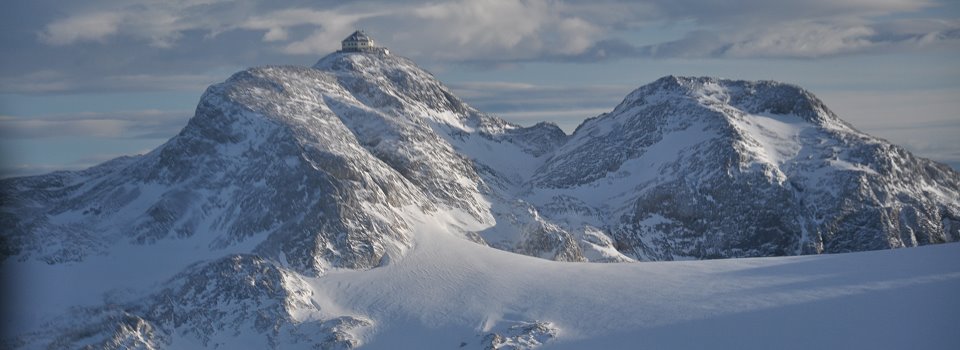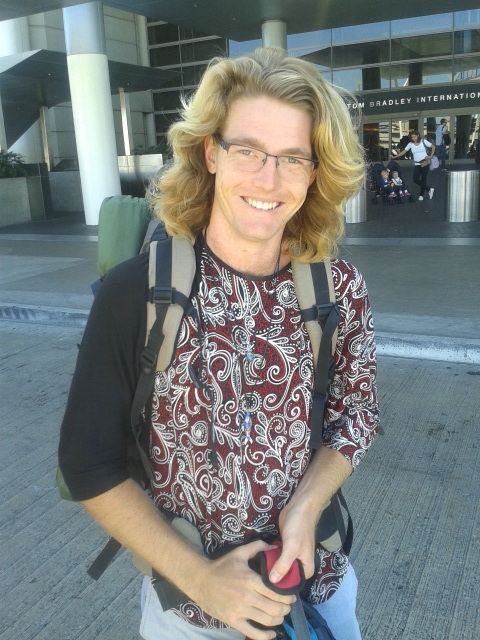 On one of my last European adventures, I found myself at the base of the Alps in a small Austrian town called Pffarwerfen. A roaring river rushed through the valley as steep meadows rose up all around. Meanwhile, massive stone peaks towered above, covered in clouds. Expecting a beautiful three days of hikes through the grass, I lifted my pack and started up the mountain. The next day, I hit the first Alpine lodge. I also hit the first fork in the trail, and decided to keep going up. Instead of spending the next two days walking through meadows at 1500 meters (about 4, 750 feet, almost a mile) above sea level, I shot up to 2900 meters and the top of the mountain range. As you climb up a mountain, it's always interesting to see how the plants change. First, there are lots of trees, then, more grass, and finally, just rock. The point where the trees stop growing is called the treeline. When I got to the top of the mountain, I was surprised to find a huge lodge right on the peak. The lodge fit over 30 people, and it had a restaurant as well. Beautiful oak all throughout the interior, as well as electricity, flushing toilets, and a number of solar panels, made me feel right at home. The lodge was called Matrashaus, and it's part of a long tradition of mountain lodges that stretches across central Europe. Matrashaus was built in 1898. It's open during the warm months of the year, and on weekends, it's often very busy. As it turns out, Matrashaus is only one of several hundred Austrian lodges, some of which are little more than a room with a stove. There is a great tradition of trekking through the mountains, and thanks to the lodges, people don't have to bring their tents and sleeping bags with them – just some clothing, food, and water. However, some of the lodges can be a bit pricey for a student (30 dollars for a night, with breakfast included), so I ended up camping on a glacier, which was an adventure on its own.
1 Comment
I'm writing this travel log a bit behind schedule. Last Sunday, I hitch hiked from Prague to Germany. Hitch hiking is when you stand by the side of the road in a safe area (gas stations are also good places), and ask people if they can give you a ride. It was my first time hitch hiking, and it was an interesting experience. Lots of people in Europe and America used to hitch hike, but today, it is far less common. Many Europeans today are worried about immigration, and they are less likely to trust strangers. Still, there are many generous people around, and I made some new friends.
I eventually ended up camping in a forest outside of the German city of Dachau with three French students. We had many interesting conversations about life in Europe and America, and we talked about everything from religion to politics. During the day, we visited the concentration camp memorial site in Dachau. During World War II, Germany was led by a very powerful man named Hitler. Hitler was able to unite people all over the country, and he made them believe that they could rule the world. One of the ways that he united people, however, was by finding groups of people to hate. Hitler blamed many of Germany's problems on Jews, as well as homosexuals, communists, and others. During the war, German soldiers hunted down millions of innocent people and put them in concentration camps such as Dachau. At Dachau, tens of thousands of people were forced to spend all day working, in sun and in snow. Those who could not work were killed. Over the course of the war, huge numbers also caught terrible diseases, while others suffered as experimental subjects for German scientists. The guards at Dachau often went out of their way to make sure that life was miserable for the prisoners. By the end, over 40,000 people died at Dachau. People have found many ways to remember the things that happened at Dachau. Some have created art that expresses parts of their experience in the camp. The memorial site has a very impressive sculpture by the artist Nandor Gild that caught my eye. It is a very powerful work, and it fit the site well. At the base, there is a simple message: Never Again. This past week, I visited family in Moravia, which is a farming region in eastern Czech Republic. Fields of green border forests and sloping hills, with many a fruit tree lining roads and villages in this sleepy part of the country. However, Moravia wasn't always sleepy. It is the site of one of the greatest battles in European history, which took place during the Napoleonic Wars. Napoleon was a French Emperor who led a huge army through most of Europe, killing hundreds of thousands of people. In Moravia, his army met the forces of the Austrian and Russian Empires at the Battle of Austerlitz on December 2, 1805.
Napoleon commanded an army of over 500,000 men. His soldiers fought with muskets, bayonets, pistols, and cannon. Ordering an army that big to march must have been a huge challenge. Just think about all of the food that everyone would need to eat! Still, Napoleon was a very smart commander, and his army moved over 600 miles in 8 weeks, all walking. He finally got to Moravia in November. Everyday people, many of them poor, were forced to give the army food, money, and other supplies. Finally, the army reached the place that Napoleon wanted to fight. The Battle of Austerlitz was long, one of the bloodiest in history. Napoleon's army took on the combined forces of Austria and Russia, which tried to break through and surround him. In the end, the French won a huge victory. Today, people remember the wars every year on Napoleon's birthday. Some dress as French, Austrian, or Russian soldiers and re-enact the battle, which means act it out just like it happened (but without real weapons). Many Moravians have found artifacts from the armies, like pistols or clothing, in their backyard. Image: https://upload.wikimedia.org/wikipedia/commons/3/33/Napoleon.Austerlitz.jpg This past weekend, I went to a music festival in eastern Czech Republic. The festival, called Colours of Ostrava, had everything from music to theater to poetry to lectures on Russia, Europe, and freedom. It was an amazing experience, with many different opportunities to learn about and explore Czech culture. One of the most interesting things about the festival, though, was the location.
Giant steel towers stood hundreds of feet above the stages, while huge buildings made of metal and brick, streaked with rust, spoke of the area's early days as a coal town. The festival took place in Dolni Vitkovice, a 200-year old coal plant where many of the city's people used to work. The factory once ran all day and all night, with giant machines turning coal into fuel, called coke. Coke was made when workers shoveled black, dirty coal into giant ovens, where temperatures usually went over 2,000 degrees Fahrenheit. Because the ovens were so hot, bad parts of the coal, like tiny bits of water, were burned off. Once the coal was burned down, or refined, into coke, the coke was then used as fuel in a blast furnace, a type of very powerful oven. Blast furnaces are used to make iron, which is then used in buildings. The plant at Dolni Vitkovice once produced 300,000 tons of foundry iron every year. Then, the plant went out of business. Luckily, though, it has been protected by local people. Some areas are now used for meetings, concerts, and other events. Today, the biggest storage tank has been turned into a concert hall that seats 1,500 people. A science academy has also been built on the property. In many places around the world, old factories are left to crumble away. It was very interesting to see how Ostrava's people transformed their old coal plant. Today, the site is a European Cultural Heritage Site, and guided tours are available throughout the year. Images: http://media.novinky.cz/000/330008-top_foto1-abpym.jpg?1345037401 http://g.denik.cz/57/b0/colours-ilustr-kab20140716_denik-380.jpg |
Adam De GreeI am a senior in college, studying philosophy, and am visiting family in the Czech Republic and travelling and studying in Europe and Asia. Archives
January 2016
Categories
All
|
|
SUPPORT
|
RESOURCES
|
|


 RSS Feed
RSS Feed



